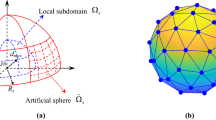Abstract
In the present paper we propose a new method for constructing a second order Moving Least Squares (MLS) approximation. The method leads to shape functions which are then used for solving Partial Differential Equations (PDE) by a collocation method. This work is an extension of the Generalized Finite Difference Method originally proposed by Liszka and Orkisz (GFDM). However it differs from GFDM by using a sequence of two first order numerical derivations based on linear polynomial basis instead of a second order derivation based on a quadratic polynomial basis. This two-stage approach leads to continuous approximation coefficients using a limited number of surrounding points and results into quite a simple program structure, very similar to that of the finite elements. The method is in an early stage of development so no definitive conclusions may be drawn, however example problems exhibit good convergence properties.
Similar content being viewed by others
Author information
Authors and Affiliations
Rights and permissions
About this article
Cite this article
Breitkopf, P., Touzot, G. & Villon, P. Double grid diffuse collocation method. Computational Mechanics 25, 199–206 (2000). https://doi.org/10.1007/s004660050469
Issue Date:
DOI: https://doi.org/10.1007/s004660050469




